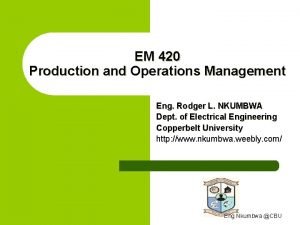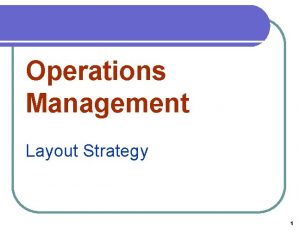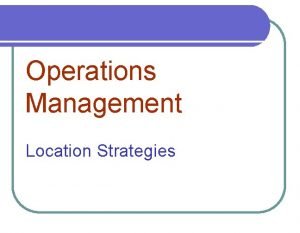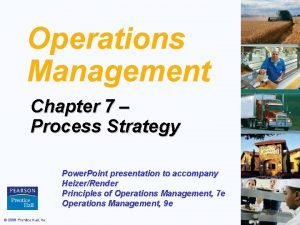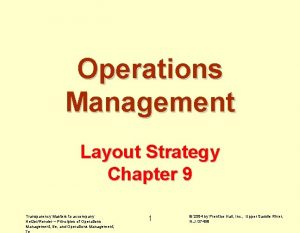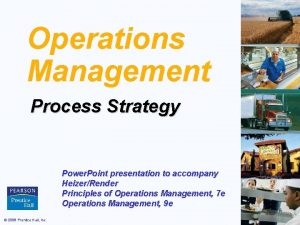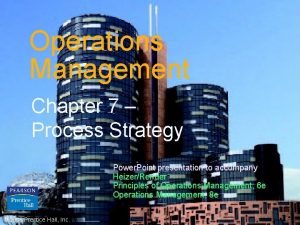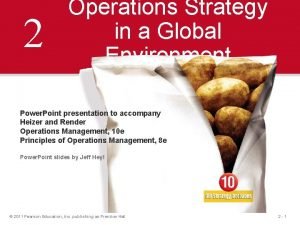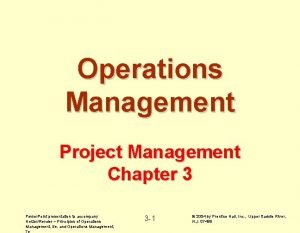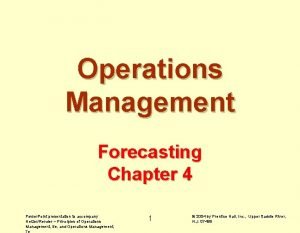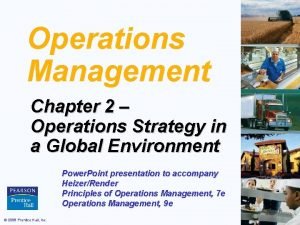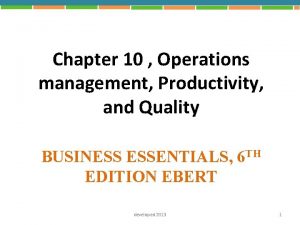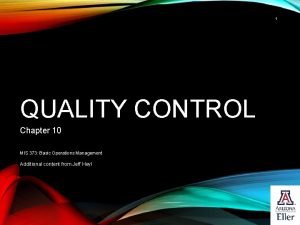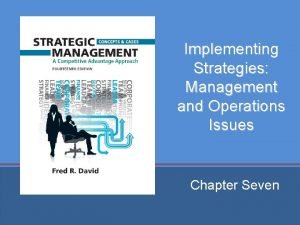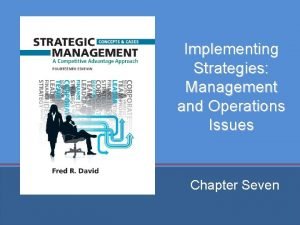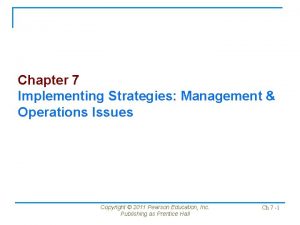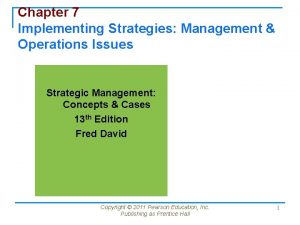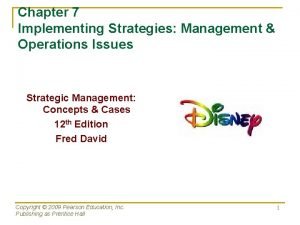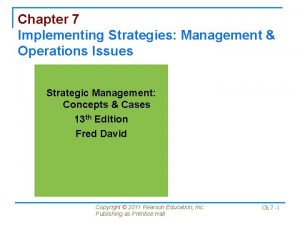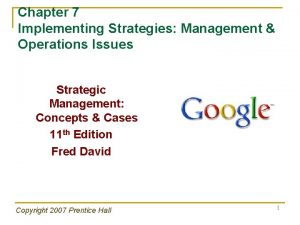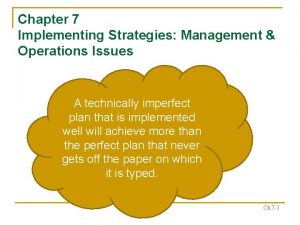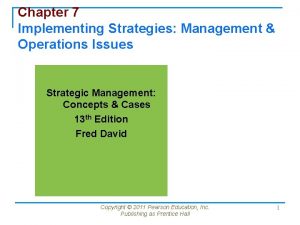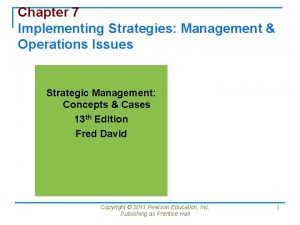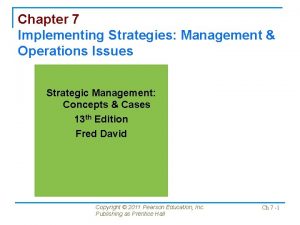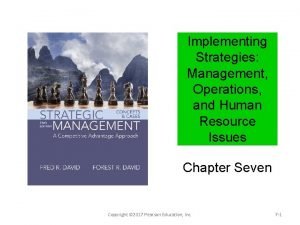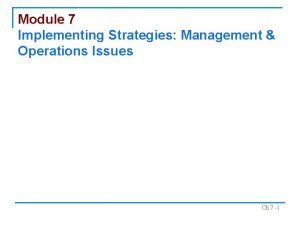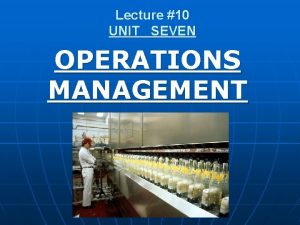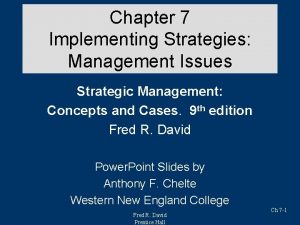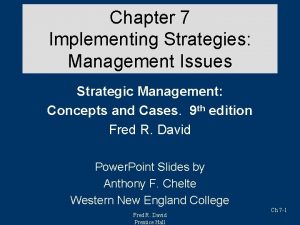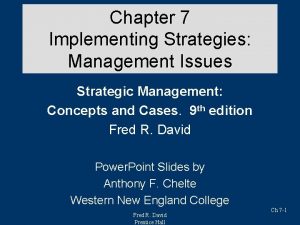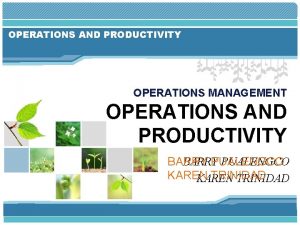Implementing Strategies Management and Operations Issues Chapter Seven

































- Slides: 33

Implementing Strategies: Management and Operations Issues Chapter Seven

Chapter Objectives 1. 2. 3. 4. 5. 6. 7. Explain why strategy implementation is more difficult than strategy formulation. Discuss the importance of annual objectives and policies in achieving organizational commitment for strategies to be implemented. Explain why organizational structure is so important in strategy implementation. Compare and contrast restructuring and reengineering. Describe the relationships between production/operations and strategy implementation. Explain how a firm can effectively link performance and pay to strategies. Describe how to modify an organizational culture to support new 7 -2 strategies.

Comprehensive Strategic. Management Model Copyright © 2013 Pearson Education 7 -3

The Nature of Strategy Implementation v Strategy formulation is positioning forces before the action. v Strategy implementation is managing forces during the action. v Strategy formulation focuses on effectiveness. v Strategy implementation focuses on efficiency. Copyright © 2013 Pearson Education 7 -4

The Nature of Strategy Implementation v Strategy formulation is primarily an intellectual process. v Strategy implementation is primarily an operational process. v Strategy formulation requires good intuitive and analytical skills. v Strategy implementation requires special motivation and leadership skills. Copyright © 2013 Pearson Education 7 -5

Some Management Issues Central to Strategy Implementation Copyright © 2013 Pearson Education 7 -6

Annual Objectives Annual objectives: 1. 2. 3. 4. represent the basis for allocating resources are a primary mechanism for evaluating managers are the major instrument for monitoring progress toward achieving long-term objectives establish organizational, divisional, and departmental priorities Copyright © 2013 Pearson Education 7 -7

The Stamus Company’s Hierarchy of Aims Copyright © 2013 Pearson Education 7 -8

Policies v Policy 9 specific guidelines, methods, procedures, rules, forms, and administrative practices established to support and encourage work toward stated goals 9 instruments for strategy implementation 9 set boundaries, constraints, and limits on the kinds of administrative actions that can be taken to reward and sanction behavior 9 clarify what can and cannot be done in pursuit of an organization’s objectives Copyright © 2013 Pearson Education 7 -9

A Hierarchy of Policies Copyright © 2013 Pearson Education 7 -10

Some Issues That May Require a Management Policy Copyright © 2013 Pearson Education 7 -11

Resource Allocation v Resource allocation 9 central management activity that allows for strategy execution 9 often based on political or personal factors v Strategic management enables resources to be allocated according to priorities established by annual objectives Copyright © 2013 Pearson Education 7 -12

Types of Resources Financial Physical Human Technological Copyright © 2013 Pearson Education 7 -13

Managing Conflict v Conflict 9 disagreement between two or more parties on one or more issues v Establishing annual objectives can lead to conflict because individuals have different expectations and perceptions, schedules create pressure, personalities are incompatible, and misunderstandings occur between line managers and staff managers Copyright © 2013 Pearson Education 7 -14

Managing Conflict v Avoidance 9 includes such actions as ignoring the problem in hopes that the conflict will resolve itself or physically separating the conflicting individuals v Defusion 9 includes playing down differences between conflicting parties while accentuating similarities and common interests Copyright © 2013 Pearson Education 7 -15

Managing Conflict v Confrontation 9 exemplified by exchanging members of conflicting parties so that each can gain an appreciation of the other’s point of view or holding a meeting at which conflicting parties present their views and work through their differences Copyright © 2013 Pearson Education 7 -16

Matching Structure With Strategy v Structure largely dictates how objectives and policies will be established v Structure dictates how resources will be allocated Copyright © 2013 Pearson Education 7 -17

Symptoms of an Ineffective Organizational Structure Copyright © 2013 Pearson Education 7 -18

The Functional Structure v Functional structure 9 groups tasks and activities by business function, such as production/operations, marketing, finance/accounting, research and development, and management information systems Copyright © 2013 Pearson Education 7 -19

Advantages and Disadvantages of a Functional Organizational Structure Copyright © 2013 Pearson Education 7 -20

The Divisional Structure v Divisional structure 9 functional activities are performed both centrally and in each separate division 9 Geographic area, product or service, customer, process Copyright © 2013 Pearson Education 7 -21

Advantages and Disadvantages of a Divisional Organizational Structure Copyright © 2013 Pearson Education 7 -22

The Strategic Business Unit (SBU) Structure v SBU structure 9 groups similar divisions into strategic business units and delegates authority and responsibility for each unit to a senior executive who reports directly to the chief executive officer 9 can facilitate strategy implementation by improving coordination between similar divisions and channeling accountability to distinct business units Copyright © 2013 Pearson Education 7 -23

Sonoco Products’ SBU Organizational Chart Copyright © 2013 Pearson Education 7 -24

The Matrix Structure v Matrix structure 9 most complex of all designs because it depends upon both vertical and horizontal flows of authority and communication v For a matrix structure to be effective, organizations need participative planning, training, clear mutual understanding of roles and responsibilities, excellent internal communication, and mutual trust and confidence Copyright © 2013 Pearson Education 7 -25

Advantages and Disadvantages of a Matrix Structure Copyright © 2013 Pearson Education 7 -26

Typical Top Managers of a Large Firm Copyright © 2013 Pearson Education 7 -27

Restructuring v Restructuring 9 involves reducing the size of the firm in terms of number of employees, number of divisions or units, and number of hierarchical levels in the firm’s organizational structure 9 also called downsizing, rightsizing, or delayering Copyright © 2013 Pearson Education 7 -28

Reengineering v Reengineering 9 involves reconfiguring or redesigning work, jobs, and processes for the purpose of improving cost, quality, service, and speed 9 also called process management, process innovation, or process redesign Copyright © 2013 Pearson Education 7 -29

Managing Resistance to Change v Force change strategy 9 involves giving orders and enforcing those orders v Educative change strategy 9 one that presents information to convince people of the need for change v Self-interest change strategy 9 one that attempts to convince individuals that the change is to their personal advantage Copyright © 2013 Pearson Education 7 -30

Ways and Means for Altering an Organization’s Culture Copyright © 2013 Pearson Education 7 -31

Production Management and Strategy Implementation Copyright © 2013 Pearson Education 7 -32

Labor Cost-Saving Tactics Copyright © 2013 Pearson Education 7 -33
 Management issues central to strategy implementation
Management issues central to strategy implementation Implementing strategies management and operations issues
Implementing strategies management and operations issues Chapter 7 strategic management
Chapter 7 strategic management Implementing strategies management and operations issues
Implementing strategies management and operations issues Ch 7
Ch 7 Designing and implementing brand architecture strategies
Designing and implementing brand architecture strategies Designing and implementing branding strategies
Designing and implementing branding strategies Designing and implementing brand architecture strategies
Designing and implementing brand architecture strategies Mis issues in strategy implementation
Mis issues in strategy implementation Enterprise resource planning ppt
Enterprise resource planning ppt Why study operations management
Why study operations management Flexibility in operations management example
Flexibility in operations management example What are the seven layout strategies?
What are the seven layout strategies? Location strategy in operations management
Location strategy in operations management Process strategy operations management
Process strategy operations management Product-oriented layout example
Product-oriented layout example Operations management presentation
Operations management presentation Four process strategies in operations management
Four process strategies in operations management Setting prices and implementing revenue management
Setting prices and implementing revenue management Chapter 12 inventory management
Chapter 12 inventory management Heavenly virtues mal
Heavenly virtues mal Checklist model project management
Checklist model project management Seven reading strategies
Seven reading strategies Strategy in global environment
Strategy in global environment Crm vision statement examples
Crm vision statement examples Operations and quality management
Operations and quality management Operations management with total quality management book
Operations management with total quality management book Operation management chapter 3
Operation management chapter 3 Operations management chapter 4 forecasting solutions
Operations management chapter 4 forecasting solutions Operations management chapter 2 solutions
Operations management chapter 2 solutions Introduction operation management
Introduction operation management Product design process in operations management
Product design process in operations management Operations management chapter 10
Operations management chapter 10 Operations management chapter 10 quality control solutions
Operations management chapter 10 quality control solutions










